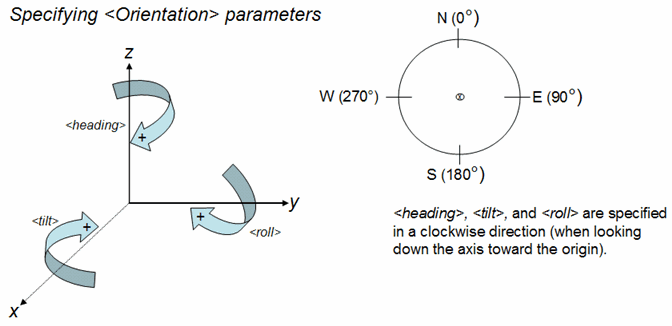 |
في ملف KML، يمكنك استيراد نماذج ثلاثية الأبعاد - مثل المباني والجسور والآثار والتماثيل - بتنسيق ملف تحويل COLLADA. يتم تحديد النماذج بشكل مستقل عن Google Earth في مكان إحداثياتها الخاص باستخدام تطبيقات مثل SketchUp أو 3D Studio Max أو Softimage XSI أو Maya. عندما يتم استيراد نموذج ثلاثي الأبعاد إلى Google Earth، يتم تحويله وتدويره وتحجيمه ليناسب نظام إحداثيات Earth. يمكن إعادة ضبط مواضع النماذج التي تم تحميلها من قبل في Google Earth وتغيير حجمها باستخدام العنصر <تحديث>. |
نموذج للنماذج
يتم استخدام نموذج في Google Earth مثل أي كائن هندسي آخر (نقطة أو سطر خطي أو مضلع). في ما يلي مثال بسيط على ملف KML يستورد نموذجًا مزخرفًا.
يمكن أن يكون مرجع النموذج رابطًا مطلقًا أو نسبيًا لمواصفات الملف، أو عنوان URL.
لعرض هذا النموذج، حمّل الملف MackyBldg.kmz، وهو أرشيف يحتوي على جميع ملفات الزخارف والتراكبات الضرورية وكذلك ملف doc.kml الذي يحتوي على النموذج:
<?xml version="1.0" encoding="UTF-8"?>
<kml xmlns="http://www.opengis.net/kml/2.2">
<Placemark>
<name>SketchUp Model of Macky Auditorium</name> <description>University of Colorado, Boulder; model created by Noël Nemcik.</description>
<LookAt>
<longitude>-105.2727379358738</longitude>
<latitude>40.01000594412381</latitude> <altitude>0</altitude> <range>127.2393107680517</range>
<tilt>65.74454495876547</tilt> <heading>-27.70337734057933</heading> </LookAt> <Model id="model_4"> <altitudeMode>relativeToGround</altitudeMode>
<Location>
<longitude>-105.272774533734</longitude>
<latitude>40.009993372683</latitude>
<altitude>0</altitude>
</Location>
<Orientation>
<heading>0</heading>
<tilt>0</tilt>
<roll>0</roll>
</Orientation>
<Scale>
<x>1</x>
<y>1</y>
<z>1</z>
</Scale> <Link> <href>MackyBldg.kmz/files/CU Macky.dae</href> </Link>
<ResourceMap id="resourcemap_for_model_4"> <Alias>
<sourceHref>../files/CU-Macky---Center-StairsnoCulling.jpg</sourceHref>
<targetHref>C:/DOCUME~1/josiew/LOCALS~1/Temp/MackyBldg.kmz/files/CU-Macky---Center-StairsnoCulling.jpg</targetHref>
</Alias>
<Alias>
<sourceHref>../files/CU-Macky-4sideturretnoCulling.jpg</sourceHref>
<targetHref>../files/CU-Macky-4sideturretnoCulling.jpg</targetHref>
</Alias>
<Alias>
<sourceHref>../files/CU-Macky-Back-NorthnoCulling.jpg</sourceHref>
<targetHref>../files/CU-Macky-Back-NorthnoCulling.jpg</targetHref>
</Alias>
<Alias>
<sourceHref>../files/CU-Macky-BrickwallnoCulling.jpg</sourceHref>
<targetHref>../files/CU-Macky-BrickwallnoCulling.jpg</targetHref>
</Alias> . . . </ResourceMap>
</Model>
</Placemark>
</kml>
يتم وضع النموذج جغرافيًا باستخدام مواصفات خطوط الطول والعرض والطول لعنصر الموقع الجغرافي. يستخدم هذا المثال القيم الافتراضية لعناصر الاتجاه والمقياس، والتي يتم تضمينها هنا للاكتمال.
يحدد عنصر الاتجاه عمليات تدوير النموذج حول المحاور x (الإمالة) وy (roll) وz (heading). يشير المحور ص إلى الشمال وهو موازٍ لخطوط الطول، والمحور س شرقًا ويوازي خطوط الخطوط. يتم تحديد التدوير بالدرجات، مع التدوير الإيجابي كما هو موضح في الرسم البياني التالي.

يعيّن عنصر ResourceMap ملفات الزخرفة من الموقع المحدد في ملف Collada الأصلي (<sourceHref>) إلى موقع في ملف KML أو KMZ (<targetHref>) يحتوي على النموذج.
ملاحظة: في الإصدارات التي تسبق إصدار Google Earth 4.2، تم إجراء وظيفة التعيين هذه بواسطة ملف textures.txt (ملف خارجي مضمن في أرشيف KMZ). يقبل Google Earth 4.2 ملفات KML وKMZ التي تشير إلى ملف textures.txt ويعالجها بشكل صحيح. عند كتابة هذه الملفات من خلال برامج Google Earth 4.2 والإصدارات الأحدث، يتم ترجمة المعلومات في ملف textures.txt إلى عنصري <ResourceMap> و<Alias>، وهما تابعان للعنصر <Model>.
إنشاء أرشيف .kmz
أرشيف KMZ هو مجموعة من الملفات المستخدمة لإنشاء عرض تقديمي KML واحد. يتضمن هذا الأرشيف جميع الملفات المحلية المشار إليها في ملف .kml، مثل الصور والزخارف والنماذج. أرشيف KMZ هو حزمة قائمة بذاتها لا يلزم استضافتها على خادم شبكة ويمكن إرسالها بالبريد الإلكتروني وتخزينها بسهولة كوحدة واحدة. يمكن لبرنامج Google Earth قراءة ملفات .kml و.kmz مباشرة.
يتم ضغط ملف doc.kml والملفات المحلية التي يشير إليها في أرشيف باستخدام تنسيق ملف ZIP. يمكن للعديد من التطبيقات إنتاج هذا التنسيق. WinZip على أنظمة تشغيل Windows وSuffit على أنظمة التشغيل Macintosh وZip على أنظمة Linux وMacintosh هي تطبيقات شائعة يمكنها قراءة تنسيق ZIP وكتابته. يمكنك أيضًا العمل باستخدام أرشيفات ZIP باستخدام مستكشف Windows أو Mac Finder مباشرةً.
بعد إنشاء ملف .zip، غيِّر امتداد الملف إلى .kmz.
يحتوي أرشيف KMZ الذي يحتوي على النموذج المزخرف الكامل لمبنى ماكي على الملفات التالية:
- doc.kml - ملف KML الموضح أعلاه، والذي يستورد نموذج COLLADA (.dae) ويضعه في Google Earth. ضع هذا الملف في الدليل الجذري لملف KMZ (ZIP).
- دليل files/ - يحتوي على ملفات COLLADA التي تحدد الأشكال الهندسية والزخارف والمواد المستخدمة في النموذج. في مثال مبنى ماكي، يحتوي هذا الدليل على ملف COLLADA (CU Macky.dae) بالإضافة إلى الملفات المتعددة التي تحتوي على صور JPEG المستخدمة في زخرفة المبنى (CU-Macky-BrickwallnoCulling.jpg، وCU-Macky--Center-StairsnoCulling.jpg، وCU_Macky-EastjpgdoornoCulling on).
يوضح هذا المثال إحدى طرق تنظيم الملفات في أرشيف KMZ. في الواقع، يمكنك ترتيب الملفات بأي بنية تبدو منطقية بالنسبة إليك، تمامًا كما تنظم الملفات في مجلدات أو أدلة على جهاز الكمبيوتر. على سبيل المثال، قد يكون من المفيد وضع جميع الصور في دليل images/. يتم تحديد المراجع النسبية (مثل الملفات المُشار إليها في العنصر <href> المستخدمة في NetworkLink وLink والتراكب/الرمز والنموذج) مقارنةً بملف doc.kml. في حالة تضمين دليل صور، ستكون مواصفات <href> لصورك كما يلي: images/myBrickTexture.jpg وimages/myMountainoverlay.png وهكذا).
